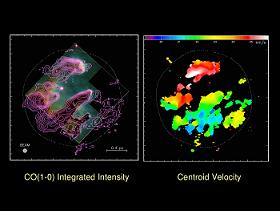|
Dynamics of Radiation Driven Molecular Clouds
With collaborators at Lawrence Livermore National Laboratory, I am
carrying out quantitative
assessment
of various models of formation of
the Eagle Nebula pillars and structures like them. This approach
combines (1) analytic theory, (2) large-scale numerical simulations, (3) scaled
laboratory verification and validation experiments on high-power
lasers,and (4) astronomical observations, with particular emphasis on
millimeter interferometry. In the picture, Left: Contours of integrated intensity of CO(1-0) in the Eagle Nebula
pillars, obtained with the Berkeley-Illinois-Maryland Association
interferometer, overlayed on Hubble Space Telescope image.
Right: Centroid velocity map derived from the CO(1-0) observations,
showing velocity gradients along the length of Pillars I and II.
[See discussion Pound (1998) ApJ, 493, L113]
|

|

